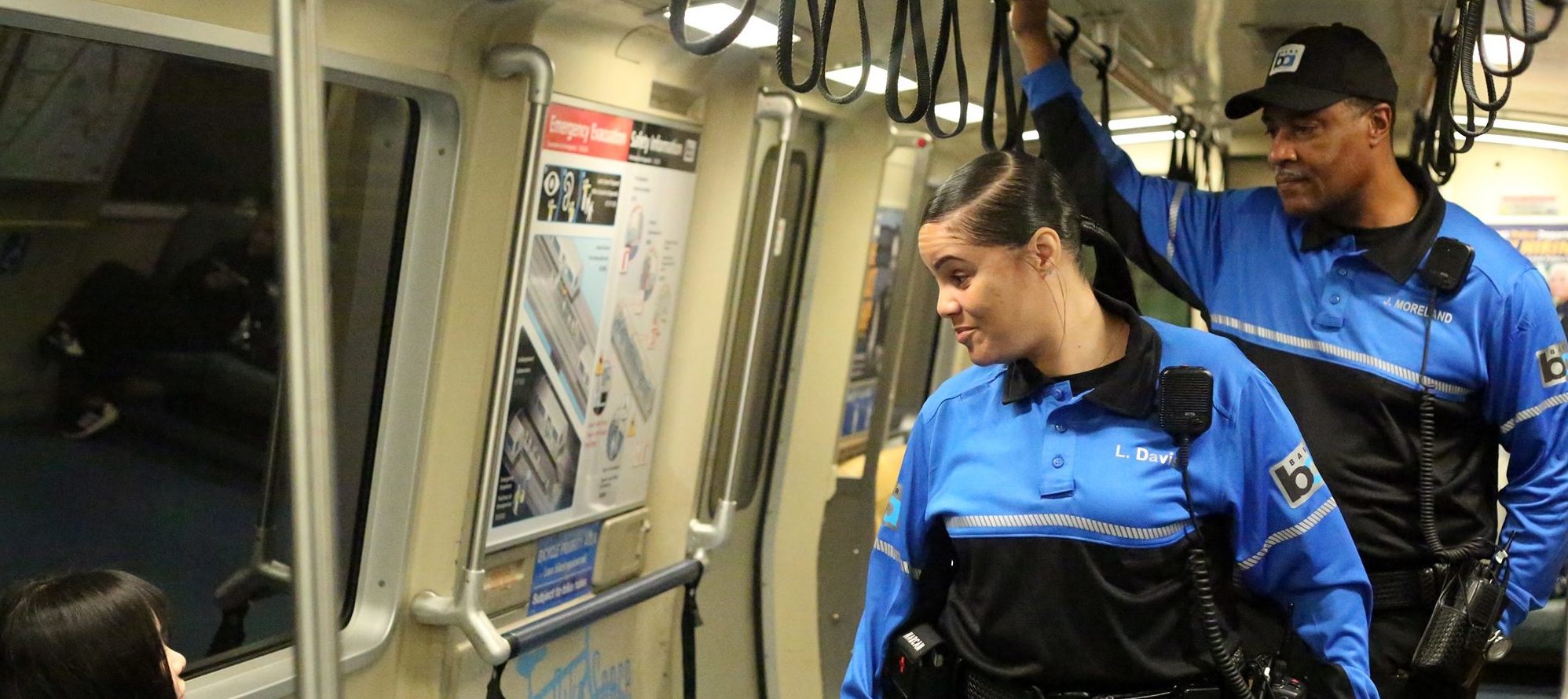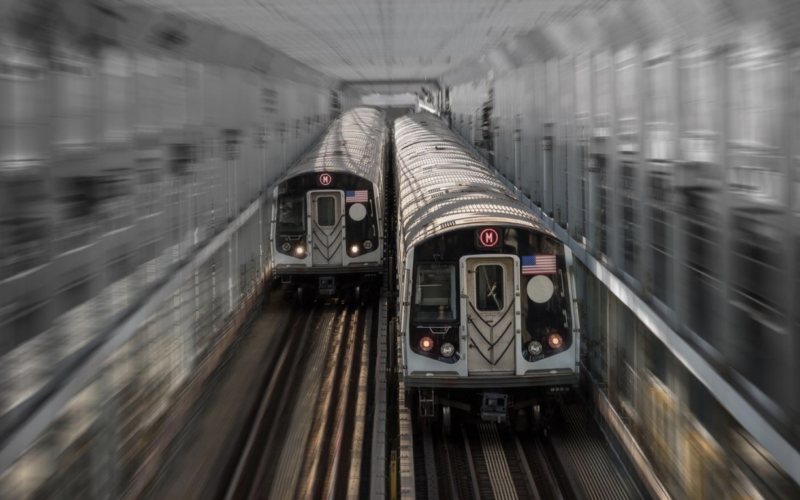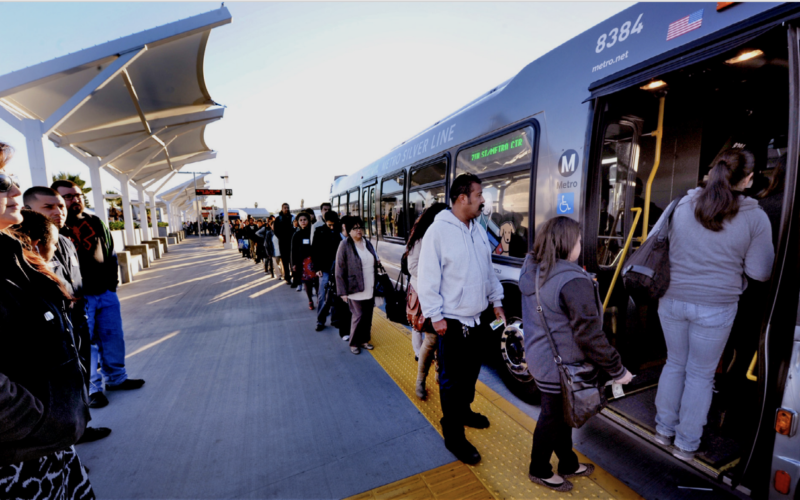
The BART Board recently voted to expand the agency's unarmed ambassador program, among other initiatives.
As protests across the nation call for an end to police violence and discrimination against Black people, the board of BART in the SF Bay Area is taking steps to overhaul the agency’s approach to public safety on transit. In June, the nine-member board voted to enact a variety of police reforms that will be instituted immediately. The board also committed to working with police reform experts and BART riders to develop a new public safety model.
In many ways, the BART police department exemplifies the limits of previous reform efforts. After a BART police officer shot and killed Oscar Grant at Oakland’s Fruitvale Station in 2009, the agency established a citizen review board and an independent police auditor. Yet bias in enforcement persists. A recent study showed that BART police issue “quality of life” violations to Black riders much more than to any other race. And as of 2018, 60 percent of BART police use-of-force incidents involved Black riders, despite the fact that only 10% of the system’s riders are Black.
Lateefah Simon, the current president of the BART board, is one of the members leading the charge to rethink policing. In her estimation, no one benefits from the current policing regime, which relies too much on armed officers to respond to wide-ranging problems on transit. In the Bay Area, like many metro regions in the U.S., policy failures like housing shortages and untreated mental illness have spilled over onto transit, and the transit police are expected to respond.
“Our police department is asked to do everything,” Simon said. “Find someone who assaulted someone at this station, deal with panhandlers, deal with homeless folks. It’s not really what they signed up to do.”
Board member Rebecca Saltzman concurs. “BART police are giving so much of their energy to dealing with these issues they’re not well equipped to deal with, which gives them less capacity to deal with crimes against people.”
This diagnosis aligns with the view of the BART police chief Ed Alvarez, who was appointed in January. “The chief and I want the same thing – we want to be smart about public safety,” said Simon. “And the chief is very clear that he doesn’t need armed officers to do everything. We can be focused on preventing violent crime, but also dealing with all of the many occurrences that happen on transit that you don’t always need an armed police officer for.”
The BART board has laid out a two-phase process for reform. First, BART officers will follow a new training protocol, including an anti-racism curriculum and strategies for dealing with people experiencing mental health crises. The agency’s operating budget also directs $2 million to double the staffing of BART’s unarmed ambassador program. The program, which launched in February, currently consists of 10 unarmed personnel who patrol the transit system, act as a friendly point of contact for riders, and de-escalate tense situations. Saltzman says the program has been a huge success so far, and she expects that doubling the program will have noticeable safety benefits.
The second phase will be shaped by a series of community conversations about public safety and policing hosted by the board in the coming months. In addition, BART will soon be hiring a firm with expertise in police reform to work with BART’s police chief, general manager, independent police auditor, and director of community relations around issues of public safety.
In October, board members will return to take up an additional slate of safety measures and reforms, informed by feedback from the public sessions and the consultant’s review. “I deeply believe that there is, like in every other sector, an opportunity to innovate, not just reform, but to innovate and to challenge the truth that we’ve held for so long about how safety must be implemented,” says Simon.
Saltzman says that getting other board members to support reform efforts hasn’t always been easy. “It took two years and a lot of negotiating to get support for the creation of the unarmed ambassador program.” But there’s been a shift recently because of the huge public outcry directed at board members. “In the past few months we’ve gotten more than a thousand emails from people all over the BART system — not just in San Francisco, in Oakland, but in the suburbs too — saying, ‘You need to either reform or defund the police.’ And so I think the board is listening. We’re an elected board, and people listen to their constituents a lot of the time.”
Simon sees limits to “defunding” and says a role remains for police on transit. “I understand the horrible calls that our police officers get sometimes every morning with horrible threats that they have to attend to. I get it. Until people don’t have to hurt each other, we’re not there yet.”
Saltzman says she recognizes that BART can sometimes feel unsafe – especially for women travelling late at night when there are very few other riders. Her vision for change addresses those concerns without relying on armed officers to handle every situation. “What we’re proposing is to actually have more BART presence on our trains. It wouldn’t just be people with badges and guns, it would be folks who can help people out, but they also have radios to radio in the police if they need them there. Having more of a presence will help make BART actually be safer but also feel safer for folks who are riding it.”
Leadership at other transit agencies should recognize that the moment to act on police reform is now, Saltzman said. “There’s a lot of energy in the country right now around this. We don’t know how long that’s going to go on, so it’s important to start soon when constituents are asking for this.”
To succeed, agencies will have to frankly and publicly address past failures to protect transit riders without racial bias, discrimination, and excessive force. “In any relationship, both parties have to be honest about what they’ve done for there to be reconciliation,” said Simon. “We need to one, honor the fact that we need to do better, and two, do everything that we can do to get it right. You don’t peel the onion of racism in eight weeks. And if there’s going to be a commitment to enhancing the vision of safety, it’s not just reimagining it, it’s enhancing it, and everyone has to feel safe.”
 Surmounting the Fiscal Cliff: Identifying Stable Funding Solutions for Public Transportation Systems
Surmounting the Fiscal Cliff: Identifying Stable Funding Solutions for Public Transportation Systems
Urban Institute's latest report, "Surmounting the Fiscal Cliff," seeks to understand why transit agencies—unlike many other public services—continuously face fiscal instability.
Read More “Who Rules Transit?” Chronicles the Gulf Between “Who Decides” and “Who Rides” at Transit Agencies
“Who Rules Transit?” Chronicles the Gulf Between “Who Decides” and “Who Rides” at Transit Agencies
Our latest report reveals a yawning gap between the demographics of transit riders – primarily women and people of color – and leadership at transit agencies – primarily white men.
Read More